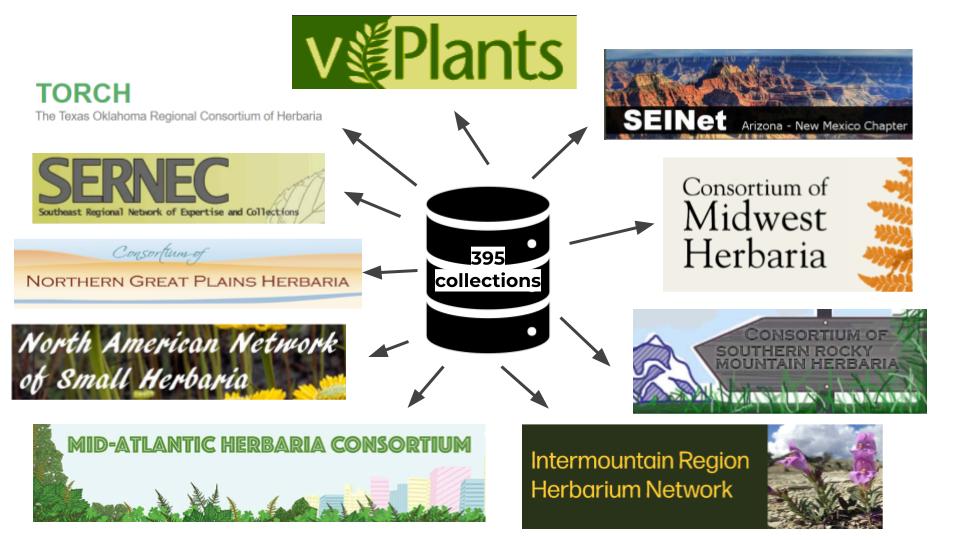Regional Network
of North American Herbaria
The SEINet Portal Network was the first Symbiota-based project to be configured as a fully integrated network of regional data repositories. SEINet currently features 11 biodiversity portals each representing a consortium of herbaria within different regions of North America. While each portal site has a different look and feel and a certain set of collections highlighted on the search page, data from all SEINet portals access a single shared database. This means, for instance, that data entered by a collection in the Intermountain Herbarium Consortium can be searched through the Mid-Atlantic Consortium portal. In this way, regional communities can maintain their own portal while still being able to take advantage of the efficiencies of a more integrated network.

Arizona – New Mexico chapter
The Arizona – New Mexico chapter of SEINet covers the southwestern region of North America with a particular interest in the arid regions.
- http://swbiodiversity.org
- Sponsors and Portal Managers
- Prior digitization support: BRC-0237418, HR-0847966
Consortium of Midwest Herbaria
This portal focuses around the Great Lakes drainage basin and includes the six states that border the western Great Lakes: Illinois, Indiana, Michigan, Minnesota, Ohio, and Wisconsin.
- http://midwestherbaria.org
- ADBC TCN NSF award #1410683: Documenting the Occurrence through Space and Time of Aquatic Non-indigenous Fish, Mollusks, Algae, and Plants Threatening North America’s Great Lakes
Consortium of Southern Rocky Mountain Herbaria
The Consortium of Southern Rocky Mountain Herbaria consists of collections from the Middle and Southern Rocky Mountain States including Colorado, Idaho, Montana and Wyoming.
- https://www.soroherbaria.org/portal/
- ADBC TCN NSF award #1702516: Documenting the Occurrence through Space and Time of Aquatic Non-indigenous Fish, Mollusks, Algae, and Plants Threatening North America’s Great Lakes
Intermountain Regional Herbarium Network
This specimen-based virtual flora covers the Intermountain Region, which is defined as the region between the Sierra Nevada and the Rocky Mountains, but the precise interpretation of the phrase varies. The region’s biota is determined in large part by its variable and scant precipitation, most of which falls in winter, and its large fluctuations in temperature, both daily and seasonal.
Madrean Discovery Expeditions & Madrean Archipelago Biodiversity Assessment Projects
The Madrean Discovery Expeditions (MDE) and Madrean Archipelago Biodiversity Assessment (MABA) Projects virtual data portals were created to serve as a gateway for the research community and general public to access a growing collection of specimen and observations records obtained from the Sky Island Region of southwestern US and northern Mexico.
Mid-Atlantic Herbaria Consortium
The Mid-Atlantic Herbaria Consortium includes herbaria from New York, New Jersey, Pennsylvania, Delaware, Maryland and D.C. The Consortium serves as the portal for the Mid-Atlantic Megalopolis Project. We invite any Mid-Atlantic herbaria to join us online in digitizing the rich resources that are our regional plant collections. See link below for more information:
- http://midatlanticherbaria.org
- National Science Foundation digitization awards: 1601697, 1600981, 1601393, 1600976, 1601429, 1601101, 1601503
North American Network for Small Herbaria (NANSH)
A unifying portal for smaller North American herbaria with various regional concentrations and affiliations. Some 15 collections included as of February, 2014, and hopefully more will join.
Northern Great Plains Regional Herbarium Network
This portal brings together information from herbaria in North Dakota, South Dakota, Nebraska, Kansas, Minnesota, Iowa, Illinois, and Missouri.
Red de Herbarios del Noroeste de México
The main objective of this site is to establish a virtual flora to assist in the exploration of the botanical biodiversity of northern Mexico, including the states of Baja California, South Baja California, Sonora, Sinaloa, Chihuahua, and Durango. This site is the first multi-lingual portal within the SEINet network.
El objetivo de este sitio web es facilitar un herbario virtual como una herramienta para consultar la gran biodiversidad de plantas silvestres del Noroeste de México, incluyendo a los estados de Baja California, Baja California Sur, Sonora, Sinaloa, Chihuahua y Durango.
- http://herbanwmex.net
- Sponsor and portal managers
SERNEC
This portal serves to network the 230 herbaria in 14 states in southeastern North America and publish on-line botanical resources that will be available to scientists, land managers, state and federal agencies, educators and the general public.
- http://sernecportal.org
- Funding and support for data digitization
- ADBC TCN NSF aware #1410069: Digitization TCN: Collaborative Research: The Key to the Cabinets: Building and Sustaining a Research Database for a Global Biodiversity Hotspot
- Portal Managers
Texas-Oklahoma Regional Consortium of Herbaria (TORCH)
This portal serves to network the ~50 herbaria in Texas and Oklahoma and publish on-line botanical resources that will be available to scientists, land managers, state and federal agencies, educators and the general public.
vPlants: a Virtual Herbarium of the Chicago Region
SEINet Steering Committee
- Gil Nelson (gnelson@bio.fsu.edu) – iDigBio
- Edward Gilbert (egbot@asu.edu) – Arizona State University, Symbiota
- Leslie Landrum (les.landrum@asu.edu) – Arizona State University
- Anna Monfils (monfi1ak@cmich.edu) – Central Michigan University
- Zack Murrell (murrellze@appstate.edu) – Appalachian State University
- Richard Rabeler (rabeler@umich.edu) – University of Michigan
- Patrick Sweeney (patrick.sweeney@yale.edu) – Yale
- Barbara Thiers (bthiers@nybg.org) – New York Botanical Garden
Funding
SEINet has been largely funded by the US National Science Foundation. Grants that have supported the growth and development of SEINet include: